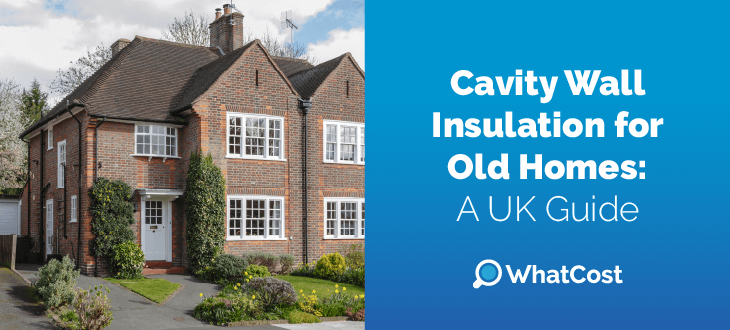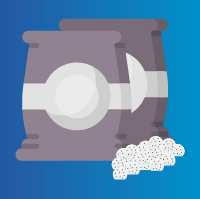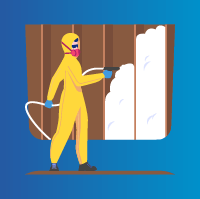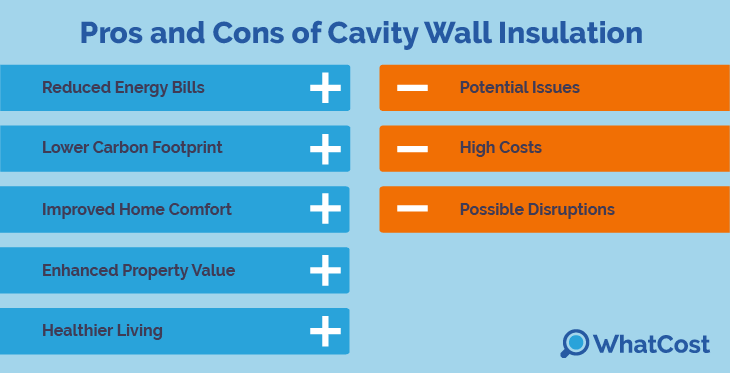Answer these simple questions and we will find you the BEST prices
Which type of solar quotes do you need?
It only takes 30 seconds
100% free with no obligation

Tell us what you need to find a matching specialist

Get free quotes from professionals near you

Compare offers and choose the one that best matches your need
- whatcost.co.uk
- Home Insulation
- Wall Insulation
- Cavity Wall Insulation
- Best Cavity Wall Insulation Old House
What Is the Best Cavity Wall Insulation for an Old House?


- EPS polystyrene beads are a great option for cavity wall insulation in old homes due its superior heat retention, durability, and resistance to moisture damage.
- On average, cavity wall insulation in old homes costs around £1,000 - £4,600 depending on your home type, size, and chosen materials.
- Cavity wall insulation is a worthy investment, bringing up to £410 in annual energy bill savings for a detached UK house alone.
Older homes, often built before modern insulation standards, can suffer from significant heat loss through their walls, leading to higher energy bills and reduced comfort. This not only impacts your savings but can even diminish your property value. For suitable older properties, wall cavity insulation can be a highly effective solution.
This complete guide by WhatCost explores the best cavity wall insulation for old houses and helps you determine if it's the right choice for your older home. We'll also guide you through each insulation material's costs, benefits and tips to land the best bargains.
Ready to insulate your home? Let WhatCost guide you to the best jobs. Instead of spending countless hours researching and vetting installers, spend just 30 seconds filling out our online intake form to receive three free home-tailored quotes from our network of trusted professionals. No costs or obligations. Just click below to begin!
Which cavity wall insulation is best for old houses?
For older homes, EPS (Expanded Polystyrene) beads are often considered the best cavity wall insulation option due to their excellent thermal performance, durability, and resistance to moisture and mould.
However, today's market boasts a wide range of insulation materials. For cavity wall insulation, there are three main approaches worth looking at, each with its own installation of cavity wall insulation. Before we get to that, let’s look at how cavity walls are insulated.
Cavity walls consist of two parallel walls with an air gap (the cavity) between them. This air gap, typically 50mm or more in older properties, provides an opportunity for insulation.
Cavity wall insulation involves injecting insulating material into the cavity space through small holes drilled in the outer wall. This non-invasive and quick process is usually completed within a few hours. However, it requires professional installation due to the specialised equipment and the need to address any existing wall issues (dampness, damage, etc.) beforehand.
To have a better understanding of the insulation material options available to you, here are the top three most common approaches to cavity wall insulation in old homes.
EPS polystyrene beads

Expanded (EPS) polystyrene beads cost around £18 - £22 per m2 and are roughly 0.5mm in diameter. When injected into the cavity space, they can expand up to 3 - 5 mm to fill the cavity. While not inherently sustainable, their moisture resistance, fantastic thermal performance and recyclability make them a great long-term solution for cavity wall insulation in old houses.
- High moisture resistance: EPS polystyrene has a very low water absorption rate. This means moisture cannot easily penetrate the beads, minimising the risk of water damage and allowing the insulation to dry out effectively even if exposed to damp conditions.
- Excellent thermal performance: EPS polystyrene boasts high heat retention, comparable to rigid polyurethane (PUR) boards and superior to standard mineral wool insulation. This translates to better energy efficiency and lower heating costs.
- Recyclable: EPS polystyrene is not natural, but is still relatively recyclable. Once removed, the beads can be broken down into their original components and repurposed to create other polymer products.
- Higher cost: EPS polystyrene bead insulation generally has a higher initial cost compared to mineral wool insulation.
- Cavity preparation: Effective installation of EPS polystyrene requires a clean cavity. Removing old insulation or debris from the cavity can be expensive and may add to the overall project cost.
Mineral wool

Mineral wool is an economical cavity wall insulation material, widely adopted due to its ease of production. It typically costs between £14 - £20 per m2 and is considered an environmentally friendly choice as it can easily be recycled and reused.
This insulation material consists of loose fibres that are injected into the cavity space using specialised equipment. However, proper air-tight sealing is crucial to prevent moisture ingress, as mineral wool is susceptible to moisture damage.
- Environmentally friendly: Made from natural materials like rock and glass, mineral wool can be produced sustainably and is often recyclable.
- Cost-effective: It is generally the most affordable cavity wall insulation option, typically ranging from £14 – £20 per m2.
- Susceptibility to moisture: Mineral wool is more prone to clumping and moisture absorption compared to other insulation materials.
- Potential for damage: Dampness and mould growth can damage the insulation, potentially requiring costly removal and replacement.
Spray foam

A foam-based substance costing £22 - £26 per m2, spray foam is injected into the cavity space between the walls of a property. This foam insulation expands to fill the cavity, creating an airtight and highly effective insulation barrier.
While spray foam insulation boasts exceptional heat retention capabilities, it is considered the least sustainable option among common cavity wall insulation materials. This is primarily due to its limited recyclability and the potential environmental impact of its manufacturing process.
- Excellent thermal performance: Spray foam boasts high thermal resistance, significantly reducing heat loss and improving energy efficiency.
- Mould resistance: Compared to many other insulation materials, spray foam exhibits superior resistance to mould growth.
- Airtight seal: The expanding nature of spray foam creates a near-perfect air barrier, effectively preventing drafts and minimising heat loss.
- Environmental impact: Spray foam is typically derived from petroleum-based products, making it non-renewable and difficult to recycle. Some formulations may release harmful volatile organic compounds (VOCs) into the environment.
- Potential for shrinkage: Over time, spray foam may experience some shrinkage, which can diminish its insulating properties and potentially create gaps that allow moisture to penetrate the cavity.
- Ventilation concerns: The expanding nature of spray foam can restrict air circulation within the cavity, potentially leading to moisture buildup and associated problems like dampness and mould.
Ultimately, there’s no ‘one size fits all’ solution for homes with old cavity walls. How long does cavity wall insulation last? If installed correctly, it should typically outlast 25+ years, with some reports claiming up to 100 years! To make the best decision for your property, it’s highly recommended to consult a professional installer. That way, they can conduct a housing assessment and tailor the best course of action for your needs.
With WhatCost, this process has never been easier! Instead of spending countless stressful hours scouring the web for installers, just spend 30 seconds filling out our online intake form, and we’ll send you 3 free home-tailored quotes from our network of pre-vetted professionals. No costs, no obligations. Simply click below to begin!
Costs and benefits of cavity wall insulation for old home
Investing in cavity wall insulation offers significant long-term savings on heating bills. While the initial cost varies depending on factors like home size, wall condition, and location, cavity wall insulation cost for a 3-bedroom semi detached UK home is around £2700.
This table provides an overview of average cost of wall cavity insulation and potential annual energy bill savings for different home types:
| House type | Average price (£) | Energy savings (£/year) |
|---|---|---|
| Apartment | £1,100 | £110 |
| Mid terrace house | £1,500 | £140 |
| Semi-detached house | £2,700 | £240 |
| Detached bungalow | £2,000 | £180 |
| Detached house | £4,300 | £410 |
The potential energy bill savings from cavity wall insulation can be substantial. For example, a 3-bedroom semi-detached home could see annual savings of around £235, meaning the initial investment could be recouped in just over 10 years.
To get an accurate cost of wall cavity insulation estimate for your specific property, it's essential to conduct a home assessment with a professional insulation company. They can assess your walls, recommend the most suitable insulation materials, and provide a personalised quote.
What are the pros and cons of wall cavity insulation for old homes?

Cavity wall insulation is a popular home improvement with numerous benefits. It can significantly enhance energy efficiency, reduce heating costs, and improve your overall home comfort. To begin with, let's have a look at the key benefits that proper cavity wall insulation can bring to older homes:
- Reduced energy bills: By minimising heat loss through the walls, cavity wall insulation significantly reduces the need for excessive heating, leading to savings on energy bills. Detached homes in the UK can save up to £405 per year on energy costs.
- Lower carbon footprint: Reduced reliance on heating systems translates to lower energy consumption and a significantly reduced CO2 footprint. For detached homes, cavity wall insulation can lead to 1.1 tonnes of annual CO2 emissions savings.
- Improved home comfort: Cavity wall insulation creates a more comfortable living environment by reducing drafts, minimising temperature fluctuations, and preventing the build-up of condensation and dampness.
- Enhanced property value: Improved energy efficiency, as reflected in a higher Energy Performance Certificate (EPC) rating, can increase the market value of your property.
- Healthier living: By reducing dampness and preventing mould growth, cavity wall insulation contributes to a healthier living environment for occupants.
While cavity wall insulation brings with it a wealth of benefits to your home and savings, there are potential cons with any insulation job that is worth being aware of. Here are some of the common complaints regarding cavity wall insulation for older homes:
- Potential issues: While generally straightforward, cavity wall insulation installation can sometimes encounter unforeseen cavity wall insulation problems. These include blocked cavities, dampness Issues, or an inadequate insulation job by an underqualified installer.
- High costs: While the long-term savings on energy bills outweigh the initial investment, the cost of professional cavity wall insulation can be a significant upfront expense for some. It’s recommended to look into UK grant programs if the costs are too high.
- Possible disruptions: Although minimal, the installation process may involve some minor disruption to daily routines due to the need for access to the exterior walls.
Overall, cavity wall insulation offers a compelling return on investment, providing long-term energy savings, environmental benefits, and improved home comfort. Whether for a cavity wall insulation new build or old build, it's crucial to choose a reputable installer to ensure thorough preparation and avoid potential issues from arising.
Is cavity wall insulation worth it for an old house?
Cavity wall insulation emerges as the single most important efficiency upgrade your old cavity-walled property can use. With the capacity to reduce over 33% of home heat loss, this can propel your savings, CO2 footprint, and home comfort to levels beyond your expectations.
However, deciding to get cavity wall insulation is only half the battle. Just as important is the need to work with an accredited professional installer who can tailor the best course of action for your home and needs through retrofit cavity wall insulation.
Sadly, finding a bargain can require countless hours of researching and vetting from you. That was until WhatCost came about!
With us, all it takes is a 30-second intake form, and we’ll send you up to 3 free home-tailored quotes from our nationwide network of trusted professionals. The best part? Our services are completely free of charges and obligations. Simply click below to begin!
FAQ
Cavity wall insulation for older houses is a great step toward energy efficiency, comfort, savings, and sustainability. By reducing more than 1/3rd of your home heat loss, it stands out as one of the most effective efficiency upgrades you can make.
You should definitely consider insulating your old house cavity walls, as such walls are particularly susceptible to high heat loss. We recommend working with a professional insulation expert who can assess your home and tailor the best course of action to meet your needs.
Cavity wall insulation will indeed make your house warmer. This is due to a better ability to retain heat within your home. By reducing heat loss, your home energy system will no longer need to work overtime to compensate for lost heat.

Akif has a keen interest in green home improvement solutions and the role of digital media in identifying climate trends. He aims to provide a multidisciplinary approach to content rooted in credible research and accuracy.
